Tapping Technique: Rhythmic Displacement of Melodies
Two-hand tapping on an electric bass can be used in a multitude of ways. One way that can be employed is the creation of improvisations in the upper register with the RH (right hand) while playing a bass line in the LH (left hand). One of the best ways to hone this skill is to play short ostinatos in the LH while slowly increasing the complexity of improvisations in the RH.
A great way to start acquiring this skill is to play a bass line that simply iterates the pulse in a very literal way (e.g. jazz swing), rather than being syncopated (e.g. funk). That way any form of syncopation can be restricted to the right-hand improvisation (see Fig.1).
Instructions:
- Tap the repetitive bass line with your LH until it becomes comfortable and you no longer have to look at the written music (see Fig.1). L1=left hand 1st finger, R1=right hand first finger, etc.
- Now count aloud simultaneously.
Fig. 1
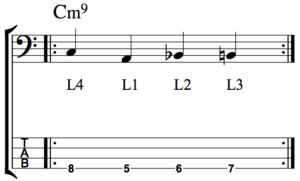
Now that you can play Fig.1 comfortably, let’s start to introduce the RH. To begin, it is important to develop your rhythmic abilities rather than adding a bunch of notes. If the bar is divided into 8th note subdivisions, there are a total of eight different rhythmic placements within the bar (i.e. 1+2+3+4+). Cultivating the ability to comfortably play a note in any of these rhythmic locations while maintaining the ostinato accompaniment is a vital prerequisite to being able to play more complex rhythms.
Instructions:
- Cycle through the different rhythmic placements––one at a time––contained in each bar of Fig.2 until you are comfortable with each of them while making sure to swing your 8th notes.
- Now see if you can count aloud simultaneously.
Fig. 2
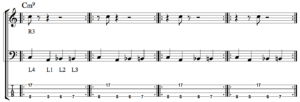
Good job! Now it’s time to add some melodic movement to the right hand from the C-minor pentatonic scale (see Fig.3). A good place to start is with a very simple rhythmic unit that only uses a couple of notes from the scale.
Instructions:
- Try tapping the C-minor pentatonic scale shown in Fig.3 with your RH ascending and descending.
- See if you can sing the pitches and say the scale degrees (show above the notes) while tapping them.
Fig. 3

Instructions:
- Play the example below in Fig.4 until you are comfortable and then begin shifting the right hand passage by 8th notes until you’ve covered all 8 positions just like in the last exercise. If it helps write out all the shifts on staff paper.
- Be able to accomplish all the shifts while counting aloud.
Fig. 4
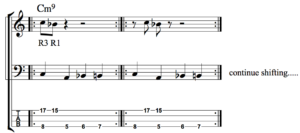
Now you are getting the hang of it. The next thing we will do is continue this same process of shifting with larger groups of notes. Later on, we will add rests between notes to create some syncopation, but for now, let’s keep our lines as unbroken sequences.
Instructions:
- Play the example below in Fig.4 until you are comfortable and then begin shifting the right hand passage by 8th notes until you’ve covered all 8 positions just like in the last exercise. If it helps write out all the shifts on staff paper.
- Be able to count aloud while performing all the shifts.
- Come up with your own melodic motives using the C-minor pentatonic scale and try shifting them.
Fig. 5
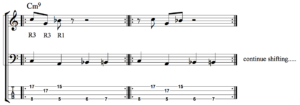
After a lot of practice with different variations, one can move on to more complex rhythms simply by inserting a rest in between what was once an unbroken sequence (see Fig. 6).
Fig. 6

Instructions:
- Work out all the shifts of the motive in Fig.7, writing them out if it helps.
- Be able to play the two parts while counting aloud.
Fig. 7
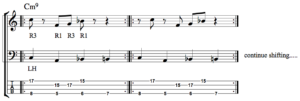
Good job for making it this far! The possibilities are endless, so never expect to work out every possible permutation or variation. The point is to gain a level of comfort that allows you to create spontaneously. If you want to take your skills to the next level try improvising freely using notes from the C-minor pentatonic scale, septatonic scales, and whatever other melodic possibilities you can use in your RH while maintaining the ostinato accompaniment in your left hand.
Josh Cohen is a multi-award winning six-string bassist, composer, session musician, and music educator. His solo six-string electric bass performances, which can be heard on his most recent 2020 album Freedom, use extended techniques to create the sound of an entire band with only one instrument without the aid of loop pedals. Josh has a new solo bass transcription book out and offers online music lessons.

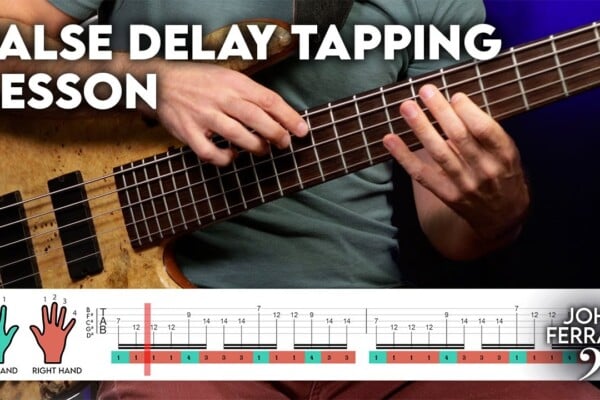
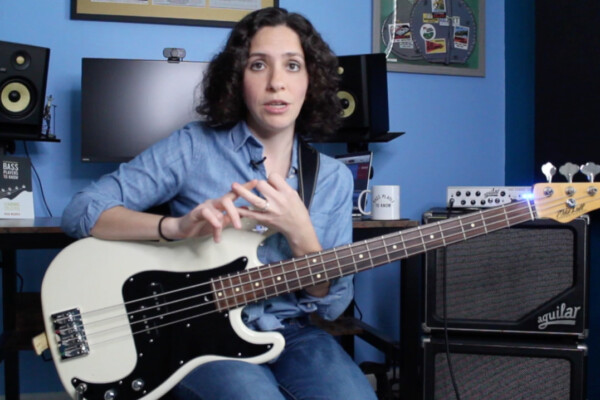
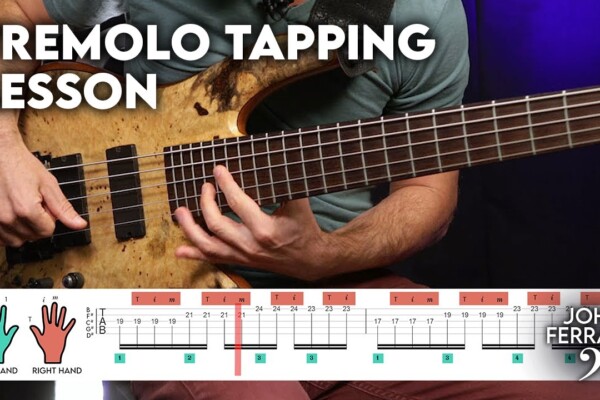
ok, now with a cool bass line.